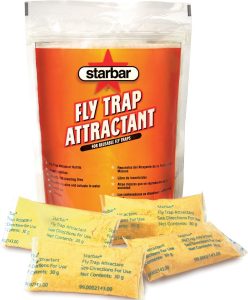The “Zero Fly Trap” is a fly-trapping device that captures and eliminates flies without harmful chemicals or toxins. It focuses on being environmentally friendly and safe for use around humans and pets. The term “Zero” in its name likely signifies zero use of chemicals, aligning with a more sustainable and eco-friendly approach to pest control.
These traps often utilize physical or naturally derived methods to attract and detain flies. Common mechanisms include UV light to lure flies, sticky surfaces, or natural bait such as sugar water or vinegar. The aim is to provide an effective solution for fly control that minimizes environmental impact and health risks associated with chemical pesticides.
How We Picked the Best Zero Fly Trap
Selecting the best Zero Fly Trap involves carefully evaluating several vital factors to ensure effectiveness, eco-friendliness, and user convenience. Here’s how the selection process typically works:
- Effectiveness: The primary criterion is how well the trap attracts and captures flies. Traps that consistently show a high catch rate are favored.
- Environmental Impact: Preference is given to traps that use sustainable, non-toxic methods for capturing flies, ensuring minimal environmental footprint.
- Safety: The chosen traps must be safe for humans and pets, especially in household environments.
- Ease of Use: The best traps are user-friendly, easy to set up, and require minimal Maintenance.
- Durability and Longevity: Traps made from durable materials that offer a longer lifespan are preferred, ensuring they don’t need frequent Replacement.
- Cost-Effectiveness: Evaluating the overall value, including initial costs and ongoing expenses (like refills or energy usage in case of electric traps).
- Design and Aesthetics: Considering the design and aesthetic appeal, especially for traps placed in visible areas.
- Customer Reviews and Feedback: Insights from user experiences and reviews provide valuable information on the real-world performance of the traps.
- Brand Reputation and Reliability: Established brands with a track record of producing reliable and effective pest control solutions are often given preference.
- Innovative Features: Any additional features that enhance the trap’s effectiveness or user convenience are also considered.
The best Zero Fly Traps can be identified by balancing these factors, offering a practical, environmentally friendly, and user-friendly solution for managing fly infestations.
Benefits of Zero Fly Trap
The potential benefits of using a Zero Fly Trap, which emphasizes a chemical-free approach to controlling fly populations, are numerous:
- Eco-Friendly: By avoiding chemical insecticides, these traps reduce environmental pollution and the ecological impact often associated with pest control.
- Safety: Zero Fly Traps are generally safer for children, pets, and food preparation areas, as they don’t contain toxic substances.
- Non-Toxic: The absence of harmful chemicals makes them a healthier choice for indoor and outdoor settings, ensuring better air quality and reducing health risks.
- Cost-Effective in the Long Run: Many of these traps are reusable or have a long-lasting effect, which can be more cost-effective over time than continuously buying chemical repellents or disposable traps.
- Easy to Use and Maintain: Zero Fly Traps are often designed for convenience, requiring minimal setup and Maintenance.
- No Resistance Build-Up: Unlike chemical methods, there’s no risk of flies developing resistance to these traps, ensuring long-term effectiveness.
- Aesthetic and Discreet Options: Many Zero Fly Traps come in aesthetically pleasing designs that can blend into the home environment more discreetly than traditional fly traps.
- Versatility: They can be used in various settings, including homes, gardens, farms, and commercial spaces.
- Targeted Control: These traps can target specific types of flies, reducing the unintended capture of non-target insects.
- Educational Value: For those interested in sustainable living practices, using and understanding the workings of a Zero Fly Trap can be educational and align with eco-conscious values.
These benefits make Zero Fly Traps compelling for those seeking practical, environmentally responsible, and safe methods for managing fly populations.
Risks of Zero Fly Trap
While Zero Fly Traps offer many benefits, particularly in terms of safety and environmental friendliness, there are also some potential risks and limitations to be aware of:
- Limited Effectiveness: Depending on the design and mechanism, some Zero Fly Traps might not be as effective as chemical alternatives, especially in areas with high fly populations.
- Regular Maintenance Required: These traps often require regular checking, cleaning, or bait replacement, which can be more labor-intensive than some chemical methods.
- Attracting Other Insects: Certain types of Zero Fly Traps, especially those using natural baits, might inadvertently attract insects besides flies.
- Potential Mess: Traps that involve sticky substances or bait can sometimes create a mess, requiring careful handling and clean-up.
- Proper Placement Needed: These traps must be strategically placed for maximum effectiveness, which might require trial and error to find the best location.
- Aesthetic Concerns: Some Zero Fly Traps might not be aesthetically pleasing, which could be a consideration for use in some regions of the home or business.
- Outdoor Limitations: Certain types of these traps may not be suitable for outdoor use, or their effectiveness could be diminished in outdoor environments.
- Time to See Results: It may take some time before a noticeable reduction in fly populations is observed, requiring patience and persistence.
- Cost: Upfront costs for some Zero Fly Traps might be higher than conventional traps or chemical methods, even though they may be more cost-effective in the long run.
- Not a Complete Solution: Like all traps, Zero Fly Traps address only the adult flies and do not tackle the source of the infestation, such as larvae or breeding grounds.
Understanding these potential risks can help manage expectations and effectively incorporate Zero Fly Traps into a comprehensive pest control strategy.
How to Use Zero Fly Trap
Using a zero-fly trap effectively involves a few straightforward steps. While the exact method can vary depending on the specific type of trap, here’s a general guide on how to use most Zero Fly Traps:
- Read Instructions: Before using, thoroughly read the manufacturer’s instructions. Different traps may have specific setup and usage guidelines.
- Choose the Right Location: Place the trap where flies are frequently seen, such as near garbage bins, compost areas, kitchens, or patios. Avoid placing traps in direct sunlight or windy areas for outdoor traps.
- Prepare the Trap: If the trap requires bait, prepare it according to the instructions. It might involve mixing a non-toxic attractant with water or preparing other natural baits.
- Set Up the Trap: Assemble the trap if necessary, and then place or hang it in the chosen location. For traps with sticky surfaces or UV lights, ensure they are fully exposed and accessible to flies.
- Regularly Check and Maintain: Regularly inspect the trap to see if it’s full or if the bait needs replacing. For traps with a collection container, empty it as needed.
- Clean the Trap: If the trap is reusable, clean it according to the instructions before setting it up again. It could involve washing with soapy water or wiping down surfaces.
- Replace When Necessary: If the trap is disposable, replace it once it’s full or no longer effective. For electric traps, check and replace bulbs or other components as required.
- Safety Considerations: If you have children or pets, ensure the trap is placed where it won’t be a hazard to them.
- Complement with Sanitation: To enhance effectiveness, complement the use of the trap with good sanitation practices, like cleaning up food spills, securely covering trash bins, and removing potential breeding sites.
- Dispose of Properly: Follow local guidelines for disposing of the trap or its contents, mainly if it contains dead flies or used bait.
Remember, while Zero Fly Traps are an effective tool in controlling flies, they are most efficient when used as part of a broader pest management strategy.
Top Zero Fly Trap To Try
Raid Essentials Flying Insect Light Trap Starter Kit, 1 Plug-in Device + 1 Cartridge, Featuring Light Powered Attraction.
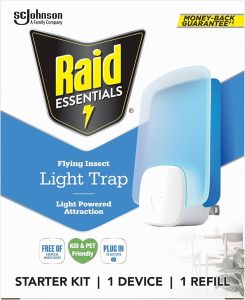
Pros of Raid Essentials Flying Insect Light Trap Starter Kit:
- Light-Powered Attraction: Utilizes light to attract flying insects, which is often more effective than bait-based traps, especially at night.
- Chemical-Free: Designed to be safer around children and pets as it does not rely on toxic chemicals to kill insects.
- Easy to Use: A simple plug-in design makes setting up and operating straightforwardly.
- Discreet and Aesthetic: The device is designed to be less intrusive and can blend into home decor more efficiently than traditional traps.
- Hygienic: Since it traps insects inside a cartridge, it minimizes contact and mess.
- Replaceable Cartridges: The ability to replace cartridges ensures long-term use and effectiveness.
- Indoor Use Suitability: It is ideal for indoor use and effective in kitchens or living rooms.
Cons of Raid Essentials Flying Insect Light Trap Starter Kit:
- Limited Range: The effectiveness is generally limited to the vicinity of the device, which might need to be increased for larger areas.
- Electricity Dependent: A plug-in device requires a power source, limiting placement options and potentially increasing electricity costs.
- Cartridge Replacements: The need for regular cartridge replacements can add to the ongoing cost.
- Attracts Specific Insects: Light attraction might be more effective for certain flying insects and less for others.
- Not Suitable for Outdoor Use: This product is designed primarily for indoor use and may need to be more effective outdoors.
- Potential Nighttime Disturbance: The light could be a disturbance, mainly if used in bedrooms or darkened environments.
Given its high customer rating of 4.9 out of 5, the Raid Essentials Flying Insect Light Trap Starter Kit is highly regarded by users, indicating intense satisfaction with its effectiveness, ease of use, and safety in controlling flying insect populations indoors.
Fly Trap Max – Extra Large Reusable Outdoor Fly Trap
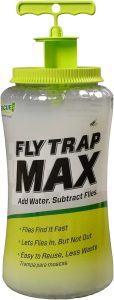
The “RESCUE! Fly Trap Max – Extra Large Reusable Outdoor Fly Trap” is a product designed for outdoor use to control fly populations. Here’s a breakdown of its potential pros and cons:
Pros:
- Extra-Large Capacity: Ideal for areas with heavy fly infestations, capable of trapping many flies.
- Reusable Design: Can be reused multiple times, making it an economical and environmentally friendly option compared to disposable traps.
- Specifically Designed for Outdoor Use: Particularly effective in outdoor settings like gardens, patios, or near animal enclosures.
- No Chemicals: Likely uses natural attractants, making it safer for the environment and non-toxic to humans and pets when used as directed.
- Easy to Set Up: Typically, such traps are straightforward to use – add bait, and it’s ready.
- Versatile Attraction: Often designed to attract a wide variety of fly species, enhancing its overall effectiveness.
Cons:
- Maintenance Required: This may require regular cleaning and rebaiting, which can be messy and unpleasant due to the nature of the bait and trapped insects.
- Odor: The bait used in outdoor fly traps often emits a strong odor, which can be unpleasant, especially if the trap is placed near living spaces.
- Visual Aesthetics: The appearance of an entire fly trap can be unsightly, which might be a concern for some users, especially in areas frequented by guests.
- Risk of Attracting More Flies: It could attract more flies if not maintained adequately.
- Location Sensitive: Its effectiveness can vary depending on where it’s placed. Finding the optimal location may require some trial and error.
- Not Suitable for Indoor Use: Designed for outdoor use, it may not be appropriate or effective indoors.
In essence, the RESCUE! Fly Trap Max is well-suited for tackling large-scale fly problems in outdoor environments. Its reusable nature and chemical-free operation are significant advantages, though users should be prepared for regular Maintenance and potential odor issues.
Safer Home SH503 Indoor Plug-In Fly Trap Refill Pack of Glue Cards
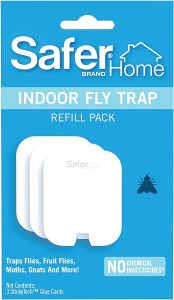
Pros of Safer Home SH503 Indoor Plug-In Fly Trap Refill Pack of Glue Cards for SH502:
- Specifically Designed Refills: Tailored to fit the SH502 model, ensuring optimal compatibility and performance.
- Ease of Use: The glue cards are easy to install, making replacing them straightforward and hassle-free.
- Non-Toxic: These glue cards offer a chemical-free method of trapping flies, making them safe for home use, particularly around children and pets.
- Effective Fly Control: Designed to effectively trap flies, helping to reduce the number of these pests indoors.
- Hygienic: The glue cards trap flies without the mess associated with traditional fly swatters or chemical sprays.
- Discreet Pest Control: Once inserted into the SH502 unit, the trap works discreetly, blending into the home environment.
Cons of Safer Home SH503 Indoor Plug-In Fly Trap Refill Pack of Glue Cards for SH502:
- Ongoing Cost: Regular Replacement of glue cards represents an ongoing cost for maintaining the trap.
- Limited to Indoor Use: These refills are designed for indoor use only, limiting their application to outdoor spaces where flies can also be problematic.
- Disposal of Dead Flies: Some users might find disposing of glue cards with dead flies unpleasant.
- Limited Range: The trap’s effectiveness is confined to the area around the plug-in device, which may need to be increased for larger rooms or heavily infested areas.
- Attractiveness to Flies: The trap’s success largely depends on the attraction of flies to the unit, which might vary based on environmental factors and fly behavior.
Given its high customer rating of 4.9 out of 5, the Safer Home SH503 Indoor Plug-In Fly Trap Refill Pack of Glue Cards for SH502 is highly appreciated by users, indicating a high level of satisfaction with its effectiveness and ease of use in controlling indoor fly populations.
Starbar Fly Trap Attractant Refill For Reusable Fly Traps
The “Starbar Fly Trap Attractant Refill For Reusable Fly Traps” is a product designed to refill for reusable fly traps. Here are some potential pros and cons:
Pros:
- Enhanced Effectiveness: Specifically formulated to attract flies, increasing the efficiency of reusable fly traps.
- Cost-Efficient: Using refills for reusable traps can be more economical over time compared to buying new traps.
- Eco-Friendly Option: Refilling reusable traps reduces waste compared to using disposable traps.
- Versatile Use: This can be used with various types of reusable fly traps, offering flexibility for users with different trap models.
- Easy to Use: Generally simple to apply, making maintaining fly traps straightforward.
- Strong Attractant: It often contains potent ingredients that are beautiful to many fly species.
Cons:
- Potential Odor: The attractant may have a strong smell, which can be unpleasant, especially when refilling the trap.
- Regular Replacement Needed: Requires periodic replenishment, which involves ongoing Maintenance.
- Attracting Unwanted Insects: Besides flies, it might attract other insects, which could be an issue in specific environments.
- Environmental Considerations: While the refill reduces waste, the ingredients and packaging still have an environmental impact.
- Handling and Storage: The attractant might require careful handling and storage due to its potent nature.
- Effectiveness Dependent on Trap Type: The overall effectiveness also depends on the type and condition of the reusable fly trap.
Starbar Fly Trap Attractant Refill For Reusable Fly Trapsoffers an effective and cost-efficient way to maintain reusable fly traps, though it requires regular maintenance and careful handling due to its potent nature.
Given its high customer rating of 4.9 out of 5, the Safer Home SH503 Indoor Plug-In Fly Trap Refill Pack of Glue Cards for SH502 is highly appreciated by users, indicating a high level of satisfaction with its effectiveness and ease of use in controlling indoor fly populations.
Black Flag, Disposable Fly Trap, Attracts All Major Fly Species
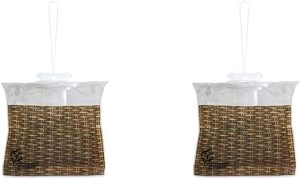
The “Black Flag Disposable Fly Trap” is designed to attract and trap various fly species. Here are some potential pros and cons of this product:
Pros:
- Convenient Design: As a disposable fly trap, it’s easy to set up and use without additional Maintenance or cleaning.
- Versatile Attraction: Designed to attract all significant fly species, increasing its effectiveness in diverse environments.
- No Chemicals: Typically uses natural attractants, making it non-toxic to humans and pets.
- Disposable: Eliminates the need for ongoing Maintenance and cleaning associated with reusable traps.
- Ready-to-Use: The trap is pre-assembled and ready for use right out of the box.
- Effective for Outdoor Use: Suited for outdoor environments where fly infestations can be expected.
Cons:
- Environmental Impact: Being disposable contributes to waste generation, which may not align with eco-conscious values.
- Limited Use: Once complete, the trap needs to be replaced, which can become an ongoing cost.
- Odor: The bait used in disposable fly traps may emit a strong odor, which can be unpleasant in specific settings.
- Visible Presence: The appearance of an entire fly trap can be unsightly, particularly in outdoor areas frequented by people.
- Specific Placement Required: Its effectiveness depends on proper Placement in areas where flies are a problem.
- Non-Reusable: Unlike reusable traps, they cannot be used multiple times, which may be less cost-effective in the long run.
In summary, the Black Flag Disposable Fly Trap offers a convenient and effective solution for trapping various fly species, making it suitable for outdoor use. However, its disposable nature and potential odor may only be ideal for some users, especially those concerned about waste generation and aesthetics.
Given its high customer rating of 4.6 out of 5, Black Flag Disposable Fly Trap is highly appreciated by users, indicating high satisfaction with its effectiveness and ease of use in controlling indoor fly populations.
Key Feature of Product
The key feature of a Zero Fly Trap lies in its ability to effectively trap and eliminate flies without the use of harmful chemicals or toxins. This core characteristic can be further broken down into several aspects:
- Non-Toxic Operation: Zero Fly Traps use physical or natural methods to attract and capture flies, avoiding chemical insecticides, significantly benefiting health and environmental safety.
- Eco-Friendly: These traps are often designed with sustainability in mind, using biodegradable materials or reusable, thereby reducing waste.
- User and Environment Safety: They are generally safe to use in homes, around children and pets, and in food preparation areas, given the absence of toxic substances.
- Effectiveness: Despite being non-toxic, these traps are designed to be effective in attracting and capturing flies, often using innovative methods such as UV light, natural attractants, or sticky surfaces.
- Ease of Use and Maintenance: Most Zero Fly Traps are user-friendly, easy to set up, and require minimal maintenance, making them accessible for widespread use.
- Versatility: They can be used in various settings, including indoors and outdoors, catering to different environments where fly infestations are a problem.
- Aesthetic Design: Many traps are designed to be discreet or aesthetically pleasing, allowing them to blend into the environment without being an eyesore.
- No Development of Resistance: Unlike chemical methods, flies are less likely to develop resistance to these physical or natural trapping methods, ensuring long-term effectiveness.
This combination of eco-friendliness, safety, and effectiveness makes Zero Fly Traps a preferred choice for those seeking a responsible and sustainable way to manage fly populations.
Potential Cons of Zero Fly Trap
While zero-fly traps offer several advantages, especially in terms of safety and environmental impact, there are some potential cons to consider:
- Limited Effectiveness: Some Zero Fly Traps may not be as immediately effective as chemical alternatives, particularly in areas with large fly populations.
- Maintenance Requirements: These traps often require regular maintenance, such as cleaning or replacing bait, which can be more labor-intensive than straightforward, disposable options.
- Attracting Other Insects: Traps using natural attractants might inadvertently lure other types of insects besides flies, potentially leading to a broader insect issue.
- Aesthetic Concerns: Depending on the design, some traps might be considered unsightly, especially in some regions of a home or business.
- Specific Environmental Suitability: Certain types of Zero Fly Traps may not be effective in all environments or weather conditions, especially those designed for indoor use only.
- Time to See Results: It might take longer to notice a significant reduction in fly populations with these traps, requiring patience and persistence.
- Higher Initial Cost: Some Zero Fly Traps, particularly those with more sophisticated designs or durable materials, can have a higher initial cost than bare fly traps or chemical alternatives.
- Not a Complete Solution: Like all traps, Zero Fly Traps primarily target adult flies and do not address the source of the infestation, such as breeding sites.
- Limited Range: The effective range of some Zero Fly Traps might be relatively small, necessitating the use of multiple units for adequate coverage.
- Risk of Non-Target Capture: Certain designs may unintentionally trap non-target species, which is a consideration for those concerned about broader ecological impacts.
Understanding these potential drawbacks is crucial for effectively integrating Zero Fly Traps into an overall pest management strategy and setting realistic expectations for their performance.
.
Expert Advice on Zero Fly Trap
Expert advice can significantly enhance the effectiveness and efficiency of Zero Fly Traps. Here are some tips and insights from pest control experts:
- Strategic Placement: Position the traps in high-traffic fly areas, such as near garbage bins, compost piles, or fruit bowls. However, avoid placing traps too close to human activity areas, as the attractants might draw flies toward those areas.
- Use the Right Bait: Select the bait based on the types of flies prevalent in your area. Different species are attracted to different scents, so understanding your pest can improve trapping success.
- Regular Maintenance: Empty and clean reusable traps regularly to maintain their effectiveness. For traps with bait, replenish the bait as needed.
- Combine Methods: Use traps with other fly control methods, such as maintaining cleanliness, properly storing food, and removing potential breeding sites like standing water.
- Adjust Placement Over Time: If a trap isn’t catching many flies, try moving it to a different location. Sometimes, even a tiny adjustment can significantly improve effectiveness.
- Safety First: If you have children or pets, ensure the traps are placed out of their reach, even though Zero Fly Traps are generally non-toxic.
- Be Patient: It may take some time before a noticeable impact is seen. Consistent use is critical for effective long-term control.
- Check for Effectiveness: Regularly assess the effectiveness of the traps. If they aren’t working as expected, consider trying a different type or changing the bait.
- Dispose of it Properly: For disposable traps, follow local guidelines for disposal, especially if they contain dead flies.
- Professional Consultation for Severe Infestations: In cases of severe infestations, consulting with a pest control professional who can offer tailored solutions and additional strategies is advisable.
Following this expert advice can help ensure that your use of Zero Fly Traps is as effective as possible, contributing to a comprehensive approach to managing fly populations.
Conclusion
In conclusion, Zero Fly Traps offers a valuable solution for those seeking an eco-friendly and non-toxic method to control fly infestations. They stand out for their safety, environmental benefits, and the absence of harmful chemicals, making them a preferred choice in settings where health and eco-consciousness are priorities.
While these traps are effective in many scenarios, especially for mild to moderate infestations, they have limited range, maintenance requirements, and time to see noticeable results. The effectiveness of Zero Fly Traps can be influenced by factors such as Placement, choice of bait, and local fly species.
Combining these traps with good sanitary practices is recommended for best results. Regular cleaning, proper food storage, and eliminating potential breeding sites are crucial steps in a comprehensive fly control strategy.
In severe infestations, consulting with pest control professionals may be necessary. Ultimately, Zero Fly Traps are a responsible and sustainable option for managing flies, aligning well with modern preferences for environmentally friendly and health-conscious living.
Final Thoughts on Products
In summarizing the evaluation of Zero Fly Traps, several key points emerge:
- Eco-Friendly and Safe: One of the most significant advantages of Zero Fly Traps is their eco-friendly nature. They provide a chemical-free option for controlling flies, making them safe to use around food, children, and pets.
- Effectiveness with Limitations: While these traps are effective for managing small to moderate fly infestations, their efficacy can vary. They offer different immediate results than chemical alternatives, especially in areas with high fly populations.
- Maintenance and Ease of Use: Zero Fly Traps typically require regular maintenance, such as cleaning and bait replacement. However, they are generally easy to use and set up.
- Cost Considerations: While some Zero Fly Traps may have a higher initial cost than traditional methods, their reusability and longevity can offer long-term cost savings.
- Versatility and Design: These traps come in various designs, some of which can be aesthetically pleasing, allowing them to blend seamlessly into different environments.
- Integrated Pest Management: Zero Fly Traps should be used as part of an integrated pest management approach for the best results. It includes maintaining cleanliness, eliminating breeding sites, and using complementary fly control methods.
- Informed Choices: Consumers should choose based on their specific needs, considering factors like the type of fly problem, the environment in which the trap will be used, and personal preferences regarding Maintenance and aesthetics.
- Educational Value: Using Zero Fly Traps can also be educational, especially for those interested in learning about sustainable living practices and eco-friendly pest control methods.
In conclusion, Zero Fly Traps represent a thoughtful choice for environmentally conscious consumers looking for effective, safe, and sustainable ways to manage fly populations. They embody a shift towards more responsible and health-conscious pest control methods, aligning with modern environmental concerns and lifestyle choices.

Aaron Ramsey, a passionate expert in the fly trap industry, combines his love for nature and innovative solutions. With a deep understanding of pest control, Aaron shares valuable insights and practical tips to create bug-free environments. His articles are a gateway to effective and eco-friendly ways of managing fly-related challenges, showcasing Aaron’s commitment to a harmonious coexistence with the natural world.
